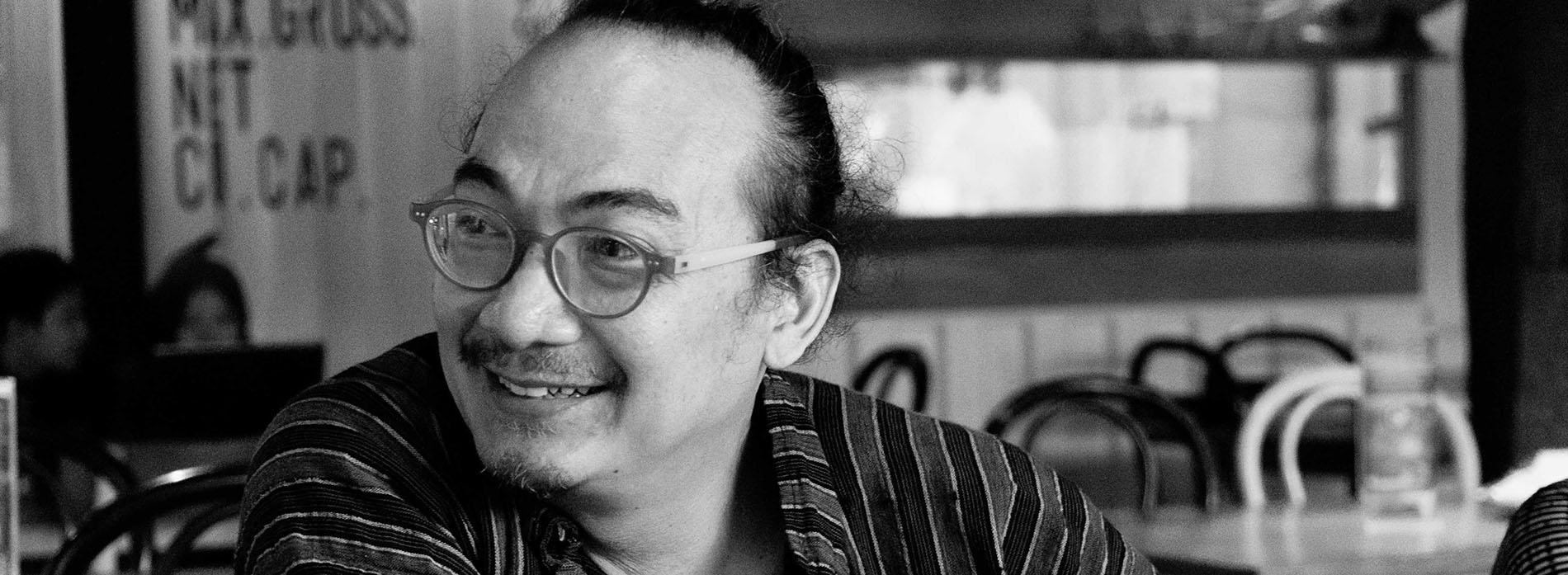TO JOIN OUR CONVERSATION
FOLLOW US AND
USE THE HASHTAG
#INDONESIAVENICE
FOLLOW US AND
USE THE HASHTAG
#INDONESIAVENICE

Heri Dono is Indonesia's leading contemporary artist, the first Indonesian contemporary artist to break into the global art scene in the early 1990s, who has since then been participating in no less than 27 international biennales. He is also the only contemporary Indonesian artist to have been invited to the Biennale Arte's own curatorial exhibition in 2003 (Zone of Urgency),
Angels, mythical monsters and the Trojan horse are three recurrent metaphors in Heri Dono's oeuvre of more than two decades of fusing the local with the contemporary. Consisting of painting, installations, video art and performance, his bizarre, grotesque images that hover between frightful and witty, satirical and moqueing appearances commenting on social and political situations have been inspired by the Javanese folk theater, the wayang, as well as by cartoons, comics and daily situations.
Angels derived from stories when he was a kid had nothing to do with religion, rather he was inspired by Flash Gordon comic strip, as he asserts that it arrived on the moon before Neil Amstrong, meaning that imagination is faster than reality. Angles became an early metaphor for freedom and dreams. “Angels are free to fly wherever they want”. But his angels, made of wood with flapping wings, a low-tech device and gender genitalia that were first created at a time of hopeful freedom, were soon flying in a cocoon, followed by a series caught in a trap and even broken in the next series, and recently facing the future, all in parallel with the social and political situation of the country.
The Trojan Horse which is symbolic of the previous times in history in which acts of war have taken place from inside the line of defence of a country, became a tool to subversively engage in activist and political actions, to infiltrate organisations and institutions, and to cross boundaries under the cover of art. “I started using this after the WTC attack in 2001 which many people think was an attack from inside the country”.
Heri Dono was born in Jakarta (1960), studied at Indonesian Institute of Arts (ISI) Yogyakarta, from which he deliberately dropped out just before graduation as he wanted to show that he could succeed as an artist without the certificate. He studied with the legendary Sukasman, who inspired him with the Javanese wayang. He resides in Yogyakarta, but is most of the time traveling, doing residencies or joining seminars elsewhere.
He is the recipient of the Prince Claus Award for Culture and Development (1998), the Unesco Prize in 2000, and the Anugerah Adhikarya Rupa (Arts Award) from the Indonesian Government (2014).
He has joined in 270 exhibitions including 27 international biennales, among others the 50th Venice Biennale in the Arsenale's Zone of Urgency, Guangzhou Triennial (2011); Gwangju Biennale (2006 and 1995); Sharjah Biennial (2005); Taipei Biennial (2004); Venice Biennale (2003); Asia Pacific Triennial (2002 and 1993); Yokohama Triennial (2001); Havana Biennial (2000); Shanghai Biennale (2000); Sydney Biennale (1996); São Paolo Biennial (2004 and 1996).
Key Exhibitions:
In Search of Meaning, Museum The Fundatie, Zwolle, Netherlands, 2015; The Roving Eye, Contemporary Art from Southeast Asia, ARTER space of art, Istanbul (2014/2015); Negotiating Home, History and Nation: Two Decades of Contemporary Art in Southeast Asia 1991-2011, Singapore Art Museum (2011); Wind from the East, Kiasma Museum of Contemporary Art, Helsinki (2007); Cities on the Move, Louisiana Museum, Humlebaek, traveled to Hayward Gallery, London, Kiasma Museum, Helsinki, Siam Centre, Bangkok (1999); Traditions / Tensions, Asia Society, New York (1996); New Art from Southeast Asia, Tokyo Metropolitan Art Space (1992); Man and Human Expression.
Public Collections:
Among others
- O.H.D. Art Museum, Magelang, Indonesia
- Deutsche Guggenheim Frankfurt, (Deutsche Bank AG Frankfurt), Germany
- Artoteek Den Haag, The Hague, The Netherlands
- Cemeti Contemporary Art Gallery, Yogyakarta, Indonesia
- Fukuoka Art Museum, Fukuoka, Japan
- Indonesian Institute of Arts, Yogyakarta, Indonesia
- Kirishima Open-Air Museum, Kagoshima, Japan
- Museum der Kulturen, Basel, Switzerland
- Australian Print Workshop, Melbourne, Australia
- Nadi Gallery, Jakarta, Indonesia
- CP Foundation, Jakarta, Indonesia
- National Gallery of Australia, Canberra, Australia
- Okinawa Art Museum, Okinawa, Japan
- Galeri Nasional Indonesia, Jakarta, Indonesia
- Queensland Art Gallery, Brisbane, Australia
- Singapore Art Museum, Singapore
- Stedelijk Museum de Lakenthal, Leiden, The Netherlands
- The Intercommunication Center, Tokyo, Japan
- Tropenmuseum, Amsterdam, The Netherlands